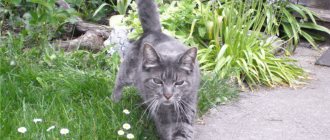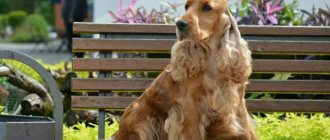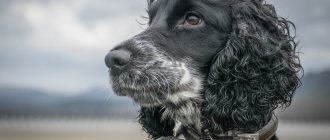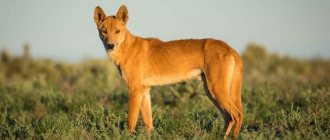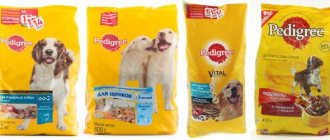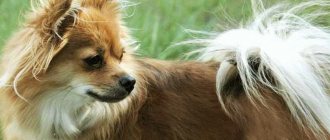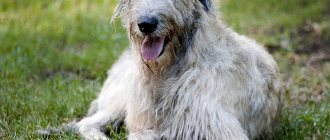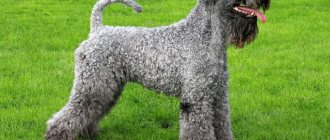Their unique, memorable appearance makes these dogs not only unique human friends, but also sets them apart from all pets. Story Chow Chow breed has its roots in millennia-old traditions and originates in China.
But Chow Chows, although they have such a charming appearance, do not have an equally sweet character. Their temperament is very independent, so the owner will have to get used to the fact that such a dog wants to be “on an equal footing” with him.
Let's go over the main aspects of the Chow Chow breed standard. Among the main and most important points in the appearance of these dogs is, of course, their lion-like appearance, to which the standard pays close attention.
History of the origin of the breed
The steppes of northern China and Mongolia are considered the homeland of the Chow Chow. Previously, dogs of this breed were used for hunting, as guards and assistants to reindeer herders, and also as sled dogs. Purebred chow chow breeding was most likely carried out by monks in Buddhist monasteries.
Due to the fact that the eastern countries were “closed” to Europeans for a long time, the first representatives of the breed appeared in England only in the 30s of the 19th century. It was from this time that selective breeding of the modern Chow Chow breed began in Europe. Now representatives of this breed are no longer considered working dogs, but decorative ones.
Video review about the Chow Chow dog breed:
Description of the breed
Chow Chows are medium-sized dogs with a strong build, proud posture and a mane that gives them a lion-like appearance .
They have a flat and wide skull, a large nose with a black or matching coat color, a non-pointed muzzle of medium length, strong jaws, a scissor bite, oval eyes, small thick ears with slightly rounded tips.
The back is short and straight, the chest is wide and deep . Chow chows have a relatively short stride, their movements are free and easy, and excess coat should not interfere with the activity of representatives of this breed.
Appearance and standards
Chow Chows are compact, strong, well-dressed dogs with a proud bearing. Their appearance speaks volumes about the fact that they are independent, serious, and self-respecting. Distinctive features of the breed are a dark blue tongue (only the Chow Chow and Chinese Shar Pei can boast of this) and a unique stilted gait. Height at the withers is 45-55 cm. Weight is 20-30 kg, but it is not critical, the main thing is that the dog is proportionate and harmoniously built.
The head is large and massive. The skull is flat, wide, without a noticeable transition from the forehead to the muzzle. Lips are full and jagged. The teeth are strong, complete with correct bite. The eyes are oval-shaped, dark. The ears are small, dense, rounded at the ends, set firmly and wide, inclined forward towards the eyes and slightly brought together. This gives the expression some scowl. The neck is slightly arched, powerful and voluminous.
The body is compact. The chest is deep and wide. The back is short and straight. The loin is wide and powerful. The tail is set high, continues the top line, and lies curled over the back. Limbs with strong bones, muscular. The front are straight, the rear with straight hocks. The paws are round and compact.
The coat is thick, dense and straight, standing upright. The coat is moderately hard to the touch, and the undercoat is soft and dense.
Based on the length of their coat, Chow Chows are divided into two types:
- Longhairs are distinguished by rich, long, thick hair that forms the collar, feathering on the legs and tail.
- Short-haired dogs are called smoothies. Their coat is similar in quality, differing only in length, which makes the dogs look plush, like British kittens.
The color can only be one color. A slightly lighter shade is allowed on the collar, pants and tail. Colors may vary:
- Black;
- Blue;
- Red;
- White;
- Mustard (cinnamon);
- Cream.
Longhaired Chow Chow
Shorthaired Chow Chow
How to choose?
If you want to buy a healthy puppy, then you need to do this from a trusted breeder . Buying second hand can result in purchasing a sick dog with breed defects.
And the shortest way to a good breeder is recommendations from Chow Chow owners.
The best age to purchase a puppy is 6-8 weeks; an older pet may already have bad habits.
In addition, a healthy baby must be:
- Well-fed, but not fat.
- Playful and cheerful.
- Have dry and clear eyes, without discharge or pus.
- The coat should be thick, dense, well-groomed.
- The surface of the ear is pink, healthy, without any unpleasant odor or dirt.
- The bite is scissor-shaped.
- The tongue is dark blue.
- The anus is clean, without signs of diarrhea or worms.
- A healthy baby's belly is neither swollen nor sunken.
- The dog must be vaccinated, groomed, have a brand and a puppy card.
A professional and responsible breeder maintains an interest in his graduate throughout his life..
Character and psychological portrait
These fluffy "bears" are wonderful companions. However, it is worth noting that the breed is not suitable for everyone. A distinctive feature of the Chow Chow's temperament is their seriousness and stubbornness; the dog considers itself completely independent, the owner must recognize this trait and respect the furry friend as a person. In general, Chow Chows are intelligent and friendly. They behave very politely and patiently with their family, but treat strangers with suspicion or cold indifference. It is better for guests of the house where the Chow Chow lives not to insist on his attention without imposing his own; the dog may react aggressively. It is also worth noting that Chow Chows do not get along well with other animals. The exception is those cases when they grew up under the same roof from childhood.
It is believed that the Chow Chow has very developed intuition. To confirm this, we can cite people's stories about how chow chows saved their owners from certain death. For example, one dog saved its owner from a house collapsing on her after an explosion, preventing her from going along her usual path. Another pet “called” a person for help when its owner was crushed under a cart. And there are hundreds of such stories.
Character
The breed is characterized by intelligence and pride. Self-esteem comes first. Independent, strong-willed dogs. The downside is stubbornness and domineering.
For the owner, the character of the Chow Chow is not a gift. Finding the right approach to a pet is more difficult than with other breeds. The dog really needs the attention of the human family, but at the same time, they can keep approval or disapproval to themselves.
The character of the Chow Chow is perfectly characterized by the phrase that has become popular among fans of the breed: “A dog is ready to die for its owner, but is not ready to obey him.”
Sudden changes in mood and lack of restraint in expressing emotions are characteristic of these dogs. They don't ask for respect, they demand it. The owner will need patience. While displaying mood swings, dogs nevertheless have very warm feelings towards both the owner and, to a lesser extent, all family members.
It is difficult to assess the behavior of this breed: they love the owner, but try to take a dominant position, are ready to give their lives for him, but do not strive to please.
The Chow Chow will not be embarrassed by any opponent if the owner is in danger. The dog will come to the defense without hesitation, using all the advantages: strong jaws, large dimensions, thick hair that protects from wounds.
Representatives of the breed are calm towards children, but if a child offends a pet, trust will be lost forever. They are distrustful of strangers - they will not show aggression without a reason, but they will not accept the attention of a stranger.
Sudden aggression can manifest itself towards other animals. He may be careful with the cat he grew up with, but this will not make it any easier for a street tabby: a chase is inevitable.
This problem can be solved by raising and socializing the puppy at an early age - to understand that aggression is not needed in most situations. It is worth remembering that centuries of work as guard dogs could not help but develop aggression as a natural reaction.
We advise you to read: American Bulldog Dog Breed
Representatives of the breed form an opinion about people and animals at the first meeting, and in the future it remains unchanged: friend, enemy, acquaintance.
The chow chow chooses the “leader” in the house independently; the decision cannot be changed. She does not show off her tender feelings, but is always ready to help and protect. Restraint in everything: barely audible whining, poking with the nose, or a slight twitch of the tail can be used to show emotions. The dog expresses dissatisfaction by growling, the volume and intensity of which depends on the degree of anxiety.
The pet is sensitive to the mood and state of health of the owner, tries to help and comfort, but absolutely cannot stand excessive emotions and temper.
Neatness and cleanliness are inherent in the breed, probably from the time of upbringing in Chinese monasteries. Puppies quickly get used to the toilet, ask to go outside, and try not to get dirty. And high self-esteem does not allow one to stoop to such banalities as damaging household items.
Rarely gives voice. Silence is one of the qualities of the breed.
Education and training
Thus, many people believe that representatives of this breed are completely resistant to training, but this is not at all true. The fact is that stubborn chow-chows will listen only to an experienced, strong-willed and strong person in whom authority is felt.
Chow Chows definitely need early socialization and training.
Babies are naturally obedient and rarely cause trouble, but adult dogs that have not been trained may refuse to recognize the owner's prestige, which will lead to a variety of behavior problems.
Sacred dogs
A key role in the formation, development and preservation of the purity of the breed was played by the servants of Tibetan temples, as well as monasteries in Northern China.
And their merit lies not only in the fact that they carried out careful selection work and bred these dogs, but they also kept detailed pedigree books.
They did not keep dogs for fur or food, because they were afraid that they would be punished by the Gods for this, so Chow Chow lived very well here.
Photo 3. Majestic view of Chow Chow
The dogs helped the inhabitants of the temples, acting as guards over the boundaries of the territory. They guarded and helped transport goods, hunted small animals and game.
All these facts were repeatedly confirmed by the stories of eyewitnesses of that time who visited these monasteries and temples.
Among them was the British Abstein, who happened to visit the territory of one of these sacred places.
He talked about how as soon as he entered the temple territory, he was immediately surrounded by a flock of lovely, large dogs with thick fur.
Even before this, a traveler from Europe - Marco Polo, well known to many - visited Tibet, from where he also brought stories about dogs that lived at temples. These descriptions date back to the 13th century.
The ancestors of the Chow Chow came to Europe much later.
The first descriptions of two dogs that were brought and placed in one of the English zoos date back to the end of the 18th century. Brought from the East, these individuals delighted the public with their unusual appearance under the slogan “wild Chinese dogs.”
However, the real excitement around the breed began after a Chow Chow puppy was presented to Queen Victoria. As a result, a decade later - in 1882 - Chow Chows saw their first exhibition, and already in 1895 the first standard for this breed was approved.
Content
Chow chows are classified as decorative dogs, but this does not mean that they are meant to live on the couch. These dogs will feel equally good in an apartment, next to the owner, provided they are walked regularly, and will easily adapt to life in the yard. Thanks to their thick fur coat, they can easily withstand even severe frosts. In addition, they will have a permanent job on the street - guarding the territory. Many owners note that chaushkas will not bark in vain only when the features of their property are under threat. As for keeping in an enclosure, a dog needs to be accustomed to it from an early age. Chow chows are quite freedom-loving and do not like change; if they are used to sleeping in the house at night, then they will ask to come back in any way.
Exercise stress
Chow Chows are calm and serious, they do not need much physical activity. An excellent option for maintaining the health of your animal’s musculoskeletal system is a daily walk in the park. You should keep your dog on a leash in public places, as his temperament can sometimes be unpredictable.
Advantages and disadvantages
Speaking about the advantages of chow chow, it should be noted that they:
- have a bright, attractive appearance;
- have good security and guard qualities;
- Suitable for keeping in apartments and enclosures;
- do not need long active walks;
- are friendly towards family members;
- loyal;
- hardy;
- clean;
- not prone to frequent barking;
- calm and balanced.
In addition, these dogs do not have a specific odor, and their coat does not provoke allergies.
Among the shortcomings are noted:
- stubbornness;
- dominant behavior;
- possible aggression towards other dogs;
- independence;
- the need for proper education and socialization.
Also considered a disadvantage of the breed is the rather heavy seasonal shedding.
Care
In order for this furry pet’s luxurious coat to remain well-groomed and beautiful, it is necessary to comb it regularly (about 1-2 times a week). The tools usually used are a comb with wide steel teeth and a slicker brush. Hairdressing scissors will be needed to trim the hair between the toes and pads.
The breed does not need a haircut. Even in the summer, it is not recommended to cut the “fur coat”, as this will disrupt the natural protection of the skin, which can even lead to burns.
During seasonal shedding, it is advisable to comb the coat daily. The owner must constantly examine his pet for the formation of tangles; most often they form behind the ears and armpits. Matts should always be removed before bathing, not after. Bathe as needed, but not more often than once every 2-3 months. For regular coat care, a “dry” shampoo is ideal, which is combed out after application.
Hygiene procedures include regular examination and cleaning of eyes, ears and teeth, and trimming of nails when necessary.
Rules of maintenance and care
Thanks to its reserved and quiet behavior, this breed gets along well and easily in apartment conditions. She will never bark and howl because of loneliness, and will not spoil furniture and things. One of the positive qualities of this breed is amazing cleanliness. But still, there must be appropriate care on the part of the owner.
Nutrition
A balanced diet is the key to a long life and good health for your pet. Therefore, it is extremely important to provide a healthy and nutritious diet to the animal, regardless of gender and age. Each meal should include micro and macroelements, vitamins and foods that ensure harmonious development and growth.
The best meats are beef or veal. Less often poultry meat. Before serving, the meat must be boiled and thoroughly cleaned of bones. By-products such as lungs, liver, heart can also be included in the diet. The best lactic acid products are cottage cheese or low-fat yoghurts.
Wheat, buckwheat, rice and pearl barley are given as carbohydrates. Among vegetable crops, your dog can be pleased with tomatoes, cucumbers, bell peppers, carrots, zucchini, boiled beets and cabbage. Among the fruits allowed, pears, apples, and bananas are allowed in small quantities. It is recommended to give berries and various nuts as treats and rewards for good behavior or fulfilled commands.
The second option for feeding is a ready-made specialized feed, in which the required ratio of proteins, fats and carbohydrates is selected, and the daily feed intake is calculated. When choosing dry food, you need to choose food of at least premium class. For an adult pet, the daily allowance is divided into 2 feedings. For puppies, it is divided into 5–6 feedings.
Haircut and combing
Chow-chows are one of those dogs that are prohibited from being cut according to the breed standard. Combing and plucking of dead undercoat hairs is allowed. You need to comb it 2-3 times a week using a special wide-toothed comb and a comb. This procedure is carried out outdoors or on a balcony with open windows. With irregular combing, the hair does not roll into tangles, but remains in the undercoat. That is, even during the molting period, the fur does not lie all over the apartment, but remains on the dog, and can then be easily removed with a comb.
Important! It is imperative to treat your dog for ectoparasites, even if it seems that there are none. Only a veterinarian can select a remedy that is suitable for a pet.
Bathing
It is recommended to bathe no more than 2-3 times a year, with a special cleaning agent for dogs with long hair.
They bathe as dirt accumulates on the coat or before shows. At the end of the water procedures, the wool must be thoroughly dried with a hairdryer.
Caring for ears, teeth and claws
Ears should be examined regularly for inflammation and earwax. Clean when dirty, about once a month with a damp cotton pad. Cleaning is carried out from the auricle to the edge of the ear.
You need to get used to brushing your teeth and caring for your mouth from an early age. Brush his teeth daily with a specialized brush and toothpaste for dogs. After each meal, inspect and clean your gums and lips from food debris. Veterinarians recommend acquiring hard toys for mechanical cleaning of teeth, as well as for jaw training.
Nails are trimmed with a specialized nail clipper for medium breed dogs, approximately 2 times a month. The sharp end of the cut claw is carefully smoothed with a nail file. It is also necessary to accustom the dog to this procedure as early as possible.
Nutrition
Chow chows are very demanding regarding the composition and quality of food. Owners need to choose the right diet based on the dog’s needs. Breeders consider feeding ready-made dry food low in protein and fat to be optimal. Dietary foods and diets for dogs prone to allergies are suitable. Puppy food may not be suitable for Chow Chow babies due to its high carbohydrate and fat content.
Feeding regimen and portions are no less important. The dog should not be overfed and taught to snack on “goodies” from the owner’s table.
For dogs on a natural diet, the main source of protein is, of course, meat. It is better to give preference to beef (an adult dog should receive at least 200-300 g of meat per day). It is better to avoid pork and chicken. Pork is too fatty, and chicken can cause allergies. By-products include beef liver and heart, and dried cartilage and tendons as delicacies. Fish is given approximately 2 times a week. Among dairy products, it is worth highlighting cottage cheese, fermented baked milk and kefir. Once a week you can treat your pet to an egg. Suitable cereals include buckwheat, rolled oats and rice.
Health and life expectancy
Chow-chow owners often have to communicate with veterinarians, unfortunately, not only on issues of prevention. Dogs are prone to various types of allergies and skin diseases. In addition, the breed has a number of diseases that are inherited:
- Myopathy;
- Adrenal insufficiency;
- Dysplasia of the hip and elbow joints;
- Inversion/inversion of eyelids;
- Anomaly of claws (splitting);
Average life expectancy is 12-13 years.
New photos of dogs
THURSDAY 02/04/2021
| Breed | Tibetan mastiff |
| Dog | Grimm |
| Nursery | No |
| Announcement | Give away No. 15357 |
| Photo | No. 113700; size: 1280 x 960 |
| Photo gallery | General album of the breed |
| Theme gallery. | No |
| Breed | German Shepherd |
| Dog | Rex Schwarzen Schloss |
| Nursery | No |
| Announcement | No |
| Photo | No. 113699; size: 3120 x 4160 |
| Photo gallery | General album of the breed |
| Theme gallery. | No |
| Breed | Italian Greyhound |
| Dog | Altsiona Amber Nero |
| Nursery | Grace Italiana |
| Announcement | No |
| Photo | No. 113696; size: 1920 x 1279 |
| Photo gallery | General album of the breed |
| Theme gallery. | No |
Choosing a puppy and the price of a chow chow
The Chow Chow is one of the most common breeds, and therefore finding a puppy of the desired gender and color will not be difficult. It is much more difficult to find a really good puppy. Given the already complex nature of the Chow Chow, it is not recommended to buy animals from random people. It is important to evaluate the character and health of the parents and contact only those breeders who have earned positive recommendations.
Puppies are born with pink tongues, but by the age of one month they become evenly colored in a darker shade. You should not trust a breeder who offers a two-month-old puppy with a spotted tongue and assures that he will soon be all colored. The paw pads, gums, lips and eyelids should also be dark.
In nurseries, the average price of a chow chow puppy is 40,000 rubles. You can buy a dog from private breeders for 15,000-25,000 rubles. Children without documents are usually sold for 10,000-15,000 rubles, but it is better to overpay for a healthy one with a stable psyche than to end up wasting energy, time and money on treatment or correcting bad habits.
Small representatives of the breed with pedigree documents, suitable for breeding in the future, will cost the future owner 12,000-20,000 rubles. The most expensive Chow Chow puppies are those who show great hope of becoming champions in the future, the so-called show-class puppies. Typically their price ranges from 30,000 and above.
Reviews of Chow Chow dogs
When we became interested in Chow Chow dogs, we collected reviews about them from everywhere we could find them: from various dog breeders forums, in comments to articles, and met with real people - the owners of these magnificent animals. One of these meetings, organized by friends, was very memorable. An emotional woman who loves her little chow-chow very much shared with us her impressions of him. You can read the text of her review - one of the most detailed and impressively descriptive - below.
9 months ago, on the advice of an old friend, I got a delightful chow-chow puppy. My admiration knows no bounds - this is the smartest and most beautiful dog I have ever seen. Calm by nature, she seems to give a feeling of peace to the people around her. Classes at the training ground convincingly prove that my pet is much smarter than the various shepherds and bulldogs training nearby. He is so tame that we could walk without a leash, because my dog rushes to me at the first order and obediently follows all commands. And he is still so small!
It is unlikely that many owners of such small pets can boast of such achievements. If I need to leave urgently, I give him the command “Sit”, and he obediently waits until I call him.
In addition to simple commands such as “Lie down” and “Stand,” which he calmly carries out before another order is given, he can also perform “complex” commands for his age, for example, he successfully performs “Fetch.” Do you think I have something to be proud of?
I am sure that my dog would not have achieved the success for which he became famous in the yard if I had not worked with him. When an animal is not trained and not given enough time and attention, it withdraws into its own little world and does not react to the world around it, remaining mediocre and brainless all its life. I have often met dogs with an indifferent and dull expression on their faces, unable to perform the simplest exercises. But it’s all their lazy owners’ fault!
I taught my pet various commands, but never gave him tasks to protect the house and yard, because he inherited the qualities of a guard and protector from his ancestors. Petty thieves broke into the house, but took nothing away. Of course, they were scared off by the menacing “lionlike” appearance of my chow-chow puppy. And I think he gave them a good bark in his incredibly deep voice. My dog is well-mannered and will not just raise his voice at passing people and other dogs, but if someone lingers at the fence, and, God forbid, tries to get into the fence, he will certainly let you know about it.
Undoubtedly, the Chow Chow's coat requires constant care. But, I really like to brush my beloved puppy, he lies and makes cute sounds reminiscent of a cat purring. He is so affectionate and good-natured, when he comes home he happily greets me and gently licks my hands.
Moreover, I have a healthy puppy, he has never had problems with his eyes or legs. But I know many owners whose dogs have various pathologies. Therefore, if you intend to purchase a purebred puppy, I advise you to carefully choose a nursery or breeder, and not buy the first puppy you come across on the market, so as not to suffer in the future.
I used to keep other dogs, they were all different with their own advantages and disadvantages. But there has never been anyone better than my inimitable, smart and sweet chow-chow puppy.
Blue tongue in chow chows: reasons
Often online, pet lovers ask the question why the chow chow has a blue tongue and what is the reason for this.
In fact, throughout the life of a dog, the tongue can change its color several times: sometimes it becomes deep black, sometimes it acquires shades up to light lilac and blue. The color may depend on:
- dog's health;
- his state of mind
- sometimes due to changes in weather.
For example, in hot weather or in a very nervous dog, the tongue may suddenly lighten.
Alas, curious dog breeders will not be able to find out why the Chow Chow's tongue is usually blue: scientists have not yet solved this mystery. Of course, there are various versions and guesses on this matter. For example, there is a legend that chow chows are distant relatives of polar wolves that existed a long time ago - millennia ago, and that this breed inherited the color of its tongue from them.
Often the Chow Chow breed is related to bears: and, indeed, the appearance of the dogs is similar to the appearance of fluffy bear cubs. Some dog experts suggest that the breed is the result of mixing Samoyeds with bears, and possibly Pomeranians. The Chow Chow in some provinces of China is nicknamed "black tongue", bear dog or wolf dog.
Many historians put forward the version that dogs came to China from Mongolia with trade caravans. And they were brought to Mongolia from Siberia, before which their homeland was the Arctic. This assumption is very plausible: blue tongues now indicate an acute lack of oxygen; perhaps, in harsh conditions, this color gradually became “native” to the Chow Chow.
Lifespan
A smooth dog can live up to 9-15 years, depending on heredity, living conditions and care. This breed is vulnerable to diseases such as:
- diabetes;
- melanoma;
- hypothyroidism;
- cataract;
- glaucoma;
- inversion or eversion of the eyelids.
A purebred puppy requires vaccinations and deworming due to its susceptibility to infectious diseases.
Chow-chow smooth puppies


